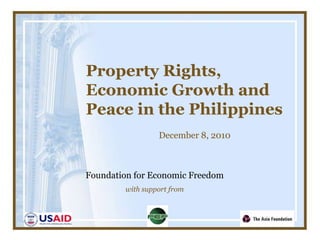
F E F Land Administration Reform
- 1. Property Rights, Economic Growth and Peace in the Philippines December 8, 2010 Foundation for Economic Freedom with support from
- 2. Property Rights in the Philippines 24 million land parcels in the Philippines Almost 50% or 12 M parcels are untitled Approximately 70% or8million untitled parcels are urban residential lands About 39 million Filipinos live on these untitled residential parcels Untitled parcels are “dead capital Neri, Consunji and One Network Bank Tax Declarations as Collateral (2006) Residential Free Patent Law (2007-2010) *Data from the Land Administration and Management Project, Land Tenure Status Report – Book 1 (year?)
- 3. Residential Free Patent Act RA 10023 passed (March 2010) and IRRs issued (May 2010) Key provisions Gives titles to “owners” at no cost Administrative procedure (not judicial) Proof of ownership reduced from 30 to 10 years No restrictions on transfer and other conveyances for titles Special Patentsallowing national and local governments to properly title lands used for public purposes such as public schools, municipal halls, public plazas, parks etc.
- 4. Challenges 1: Institutional Framework Institutional arrangements (legal/organizational/operational) do not promote integrated land administration system underpinned by an effective cadastral framework DOJ: Land Registration Authority, Register of Deeds DENR: Land Management Bureau, NAMRIA etc. The cadastre is essentially a methodically arranged public inventory of data concerning all legal land objects, based on a survey of their boundaries and are systematically identified Poor inter-agency coordination results in information also scattered Strong resistance to integrating land agencies (Land Administration Reform Act – 2004-2010)
- 5. Cadastral Parcel and Ownership Rights Source: Land Administration (Peter Dale and John McLaughlin)
- 6. Multi-purpose Cadastre Components Tenure and value records Administrative records Other parcel-related records Resources records Other records related records Parcel id Other Identifiers Cadastral boundary overlay Other overlays jhgjhjh Data-exchange Conventions Base maps Geodetic Reference Framework Source: National Research Council 1980
- 7. Sample Cadastral Index Map
- 8. Sample Land Use Map
- 9. Challenges 2: Organizational Capacity 5,000: No. of Titles issued by DENR under Residential Sales per year 1,000: No. of Titles issued by Judiciary per year At the present rate, 1,300 years to title the remaining residential parcels
- 10. FEF Property Rights Project (2009-2012) Objectives Increased issuance of residential free patents through cooperation of LGUs LGU Land Offices established for integrated land information based on multi-purpose cadastre Rationale Expanding role of LGUs in land management (i.e. UDHA law) Information of national agencies based mostly on LGU data LGUs have regular interaction with parcel holders (i.e. tax payments)
- 11. Policy Reform DENR Department Administrative Order Devolve select land administration functions to local government to assist national agencies in cadastral surveying, land titling and land information management LGU Executive Order Individual LGUs can independently establish a land office Draft prepared for Cebu City
- 12. Research and Public Information Development Impact of Multi-purpose Cadastre in Local Government Trends and Challenges in Land Administration and Management at the LGU RFP Policy Brief
- 13. Pilots Purpose Achieve development outcome (titles, investments, loans, economic activity etc) Develop a Toolkit for other LGUs Cebu Possible pilots: Angono and Tanay, Rizal
- 14. Conclusion Secure property rights are essential for a prosperous and peaceful Philippines The Residential Free Patent titling program provides a framework spur economic growth and job creation by boosting investment in land and housing assist in addressing the fiscal challenges promote social cohesion by giving beneficiaries an economic stake in society LGU-led programs can play a central role in property rights
- 15. THANK YOU!
